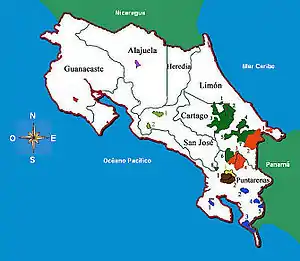Indigenous territory (Costa Rica)
According to Costa Rica’s 1977 Indigenous Law, the Indigenous Territories are the traditional lands of the legally recognized indigenous peoples of Costa Rica.[1] The Republic of Costa Rica recognizes eight native ethnicities; Bribris, Chorotegas, Malekus, Ngöbe, Huetars, Cabecars, Borucas and Terrabas.[2]
The Law also provides the territories of self-government and autonomy according to the traditional organization of the tribes, yet this is hardly applied.[1] According to the Law all non-indigenous residents with properties in the areas acquired before the promulgation of the Law should be relocated and/or indemnified, and all posterior acquisition of lands is illegal and should be expropriated with no compensation,[1] but this hasn’t been endorsed by Costa Rica’s government.[1] Tension between indigenous and white residents of the areas of Salitre and Cabagra has become violent to the point of mutual aggressions.[3]
Territories
Currently there are 24 officially recognized indigenous territories:
Notes
- Schliemann, Christian. "La autonomía de los pueblos indígenas de Costa Rica una contrastación del estándar internacional con la legislación nacional y su implementación". Revista Latinoamericana de Derechos Humanos (in Spanish). n 23 (1) (I Semestre 2012): 23 145. ISSN 1659-4304.
- "Indigenous peoples in Costa Rica." International Work Group for Indigenous Affairs. Retrieved 2 Dec 2013.
- United Nations. "Naciones Unidas llama a detener violencia en Salitre y a asegurar derechos para habitantes de territorios indigenas". Retrieved 18 April 2016.

.svg.png.webp)